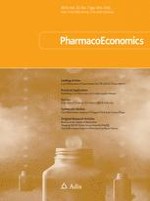01-07-2014 | Original Research Article
Mapping EQ-5D Utility Scores from the PedsQL™ Generic Core Scales
Published in: PharmacoEconomics | Issue 7/2014
Login to get accessAbstract
Purpose
The Pediatric Quality of Life Inventory™ (PedsQL™) General Core Scales (GCS) were designed to provide a modular approach to measuring health-related quality of life in healthy children, as well as those with acute and chronic health conditions, across the broadest, empirically feasible, age groups (2–18 years). Currently, it is not possible to estimate health utilities based on the PedsQL™ GCS, either directly or indirectly. This paper assesses different mapping methods for estimating EQ-5D health utilities from PedsQL™ GCS responses.
Methods
This study is based on data from a cross-sectional survey conducted in four secondary schools in England amongst children aged 11–15 years. We estimate models using both direct and response mapping approaches to predict EQ-5D health utilities and responses. The mean squared error (MSE) and mean absolute error (MAE) were used to assess the predictive accuracy of the models. The models were internally validated on an estimation dataset that included complete PedsQL™ GCS and EQ-5D scores for 559 respondents. Validation was also performed making use of separate data for 337 respondents.
Results
Ordinary least squares (OLS) models that used the PedsQL™ GCS subscale scores, their squared terms and interactions (with and without age and gender) to predict EQ-5D health utilities had the best prediction accuracy. In the external validation sample, the OLS model with age and gender had a MSE (MAE) of 0.036 (0.115) compared with a MSE (MAE) of 0.036 (0.114) for the OLS model without age and gender. However, both models generated higher prediction errors for children in poorer health states (EQ-5D utility score <0.6). The response mapping models encountered some estimation problems because of insufficient data for some of the response levels.
Conclusion
Our mapping algorithms provide an empirical basis for estimating health utilities in childhood when EQ-5D data are not available; they can be used to inform future economic evaluations of paediatric interventions. They are likely to be robust for populations comparable to our own (children aged 11–15 years in attendance at secondary school). The performance of these algorithms in childhood populations, which differ according to age or clinical characteristics to our own, remains to be evaluated.





